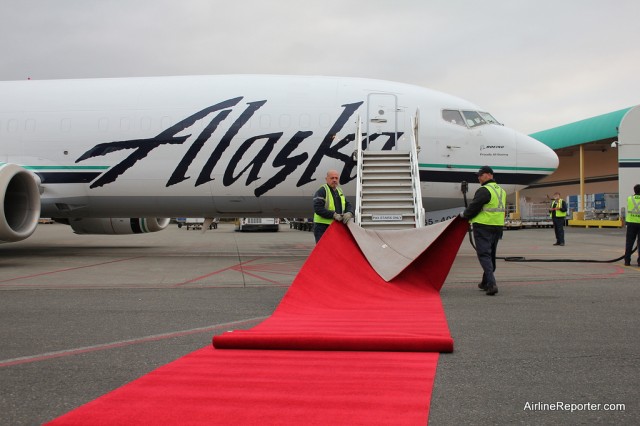
For the record, I feel that Alaska pulls out the red carpet for most passengers. Heck. This red carpet is for a fish — imagine what they do for people.
I have not really gone on a rant in a while and I think it might be time. My apologies for those of you who might not be rant-fans, but this is happening.
Part of running this website means I get quite a few emails, Tweets and stories on how people had the worst experience ever flying on an airline. I feel it is a duty for me to read every story to see if there is any merit. Out of the hundreds of “horror” stories I have received, a handful (at best) have had any merit. Anyhow, I decided a recent outburst on an airline was a good time to share some thoughts I have on passengers overreacting and customer service in general.
My semi-apologies to @rexfox for being my real-life example on this story. His experience and actions are an amalgamation of hundreds that I have seen, he just gets to be the lucky one that I use. Do I feel bad calling him out? Not really. I mean almost all these angry passengers are asking me to write a story on their issues, to “spread the word of mistreatment.”
Probably not exactly in the way he wanted, but oh well. He publicly ranted on an airline, pulled me into his rant, so it is fair game for me to use. Unfortunately, Alaska Airlines also gets dragged into this mess, but I think this could be any airline.
Okay, let’s start this… I first “met” @rexfox after he replied to a Tweet, where I let my followers know about Alaska Airlines posting their college internships.
NOTE: Some of the language that he uses isn’t the best. I figure most of us are adults here (if you can’t handle it, stop reading please).

Okay, this is not that bad. But I had time on my hands and was curious why he would take the time to message the airline and me to let us know about his mistreatment. I went to his Twitter account and next found this.

Hmm. Not as nice sounding as my Tweet, he seems to be a bit angrier with @theflyingpinto than he was with me. I can promise you that actually being an “asshole” is something that Alaska is NOT looking for in new employees. I can also say, that if you want a legitimate response from an airline, do not use cuss words. I decided to keep reading.

First off (I had to look this up), but the Kenai seems to still have fish. Secondly, threatening one airline by saying you will fly another is quite overused and doesn’t really work. You know how many times airlines hear, “I will never fly you again?” Don’t get me wrong, an airline should want to try to keep your business, but passengers threaten this all the time, so it makes no impact. My advice is to stick with the problems you experienced and see if the airline can resolve them. If they can’t, show them with your pocket book and actually never fly them again.
BONUS: The five stages passengers go through when flying ultra low-cost carriers
Sometimes throwing out that you are an elite mileage member can be helpful, but others it can backfire. The first thing is do not lie. If you say you are some uber golden child member and the airline looks you up and lied, you hurt your case. Yes, airlines have more invested in those that fly often, but no company wants any of their customers to be treated poorly — so just own your status (no matter if you have none).
They also will know that if you have a bazillion miles with the carrier, you aren’t going to start flying a new airline at the drop of a hat. You have worked way too hard getting those miles just to throw them away. Because of these reasons, I normally suggest keeping your status on the down low — at least for now.
I digress. @rexfox never states he is an elite member of Alaska’s mileage program, but does hint that he has a miles credit card. I have to give him props (pun intended) for not trying to throw status around.
One of the most amusing parts of his rant is he makes it seem like he is leaving Alaska for American, but only a bit earlier, he threw them under the (air) bus:

This Tweet is amusing for a few reasons. First off, he just said that he was moving to American, but now is saying to boycott the airline? Also, he went back to April 2012 to make a comment on this Tweet? That is dedication to show off your anger for an airline.
He spent quite a bit of time trying to prove his point. In a matter of less than four hours, @rexfox Tweeted 24 times about being angry at Alaska Airlines. Many of them were just Re-Tweeting negative stories on the airline.
BONUS RANT: Breaking News: OMG, Flight Delayed One Hour ’“ Thoughts on the Airline Hate Mail I Receive
I guess the point he was proving was that he was angry — quite angry, but I still did not know why. I was starting to think that maybe this guy actually had something that was so horrid to warrant this response. I kept on scrolling… ah, here we go:

The F-word. Nothing says, “please give me a legitimate customer service response,” like dropping the F-bomb. With my experience in customer service, even if you have a legitimate complaint/request, it is all over when that word starts to be used.
See, even I got distracted about his initial complaint because of his language. Let’s take a look at his actual complaint, which could be legitimate. Do not mind the grammar, that is just since it was on Twitter, let me try to sum it up:
He has flown 3 times around the world (which is 300,000 miles I guess) with this bag and never been hassled before. Then an employee (I am guessing gate agent) in Vegas explained that his bag was too large and even though he requested she measure it, she refused. Did I get that right? I am guessing it resulted in him having to gate check his bag, which normally Alaska will not charge in those situations.
I can see this being frustrating. I have had this happen to me before as well. I also realize that Alaska operates the 737NG with larger overhead bins and the older 737-400 with smaller bins. I know my bag will not fit in the -400, but will on the NG. I am sure most passengers do not realize it and not really sure how well the airline communicates that to passengers.
Even giving @rexfox the benefit of the doubt and Alaska was rude and forced him to check his bag with no explanation, does all that warrant his reaction? (I am also going to take a wild guess that based on his Twitter rant made after he cooled down, he probably did not treat the Alaska employee with much respect).
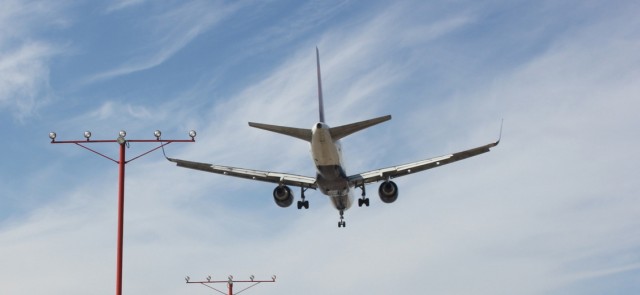
You had to check your bag? Sucky. Did you still fly half way across the world in less than a day? Yea…
Maybe he just needed to rant to feel better. But then why bring in the employee’s name (which I removed, since she was doing her job). With his initial complaint, along with flight and name details, I would be willing to bet he would have received some reply from Alaska. I am sure they want their gate agents to be able to explain that this particular airplane has smaller overhead bins than others that they fly and that is why his bag needs to be checked.
I have found that Alaska is quite responsive to upset customers, but after his rant, no good pubic relations or customer service representative is going to mess with his situation.
The lesson here is simmer down and put things in perspective. Is being told that your bag is too big and forced to check it annoying? Sure. Is it worth getting this angry and spending four hours letting people know how horrible you think an airline is? Probably not. Will Alaska change their bag policy? Doubtful. Will he actually change what airline he ever flies because of this? No. If you have a legitimate complaint, let the airline know (in a calm manner) either via social media or email. I promise you that almost all airlines read every letter and passenger feedback (good or bad) that can change an airline’s policy.
What do you think? Am I being too hard or soft on this guy? What advice do you have for interacting with an airline when you have a complaint? Leave those thoughts in the comments.
 |
This story written by…David Parker Brown, Editor & Founder. David started AirlineReporter.com in the summer of 2008, but has had a passion for aviation since he was a kid. Born and raised in the Seattle area (where he is currently based) has surely had an influence and he couldn’t imagine living anywhere else in the world.@AirlineReporter | Flickr | YouTube |
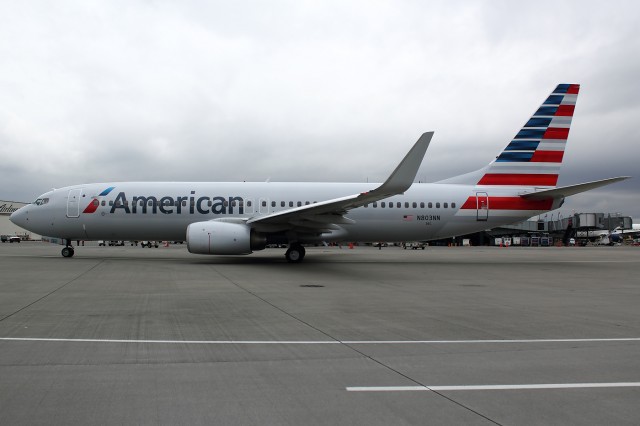
American Airlines Boeing 737 (N803NN) with new livery seen for the first time in Seattle. Image by Brandon Farris.
I recently had the chance to see up close and personal the New American Airlines scheme when it arrived to Seattle-Tacoma International Airport (SEA) for the first time, and have to say, pictures do not do it justice. Previously I was quoted on AirlineReporter.com saying that the new design was,’œFugly.” You could say I was not a huge fan.
Seeing it person really makes a huge difference. The logo stands out on the front of the plane and reaches back just before the emergency exit. Then we get to the tail, from a distance it is not the sharpest looking thing in the world but up close American Airlines seems to have hit a home run with it. Though it looks like as one person described, drawn via a crayon, it is artistic looking compared to what has become the dull Red and Blue AA that has graced the tail for far too many years.
I have seen quite a few people say that the design will not stand out among the gray sky. Obviously, SEA is known for its gray sky and during the 737’s visit, it was surely gray, but the tail stood out. I couldn’t imagine what it will look like on a sunny day.
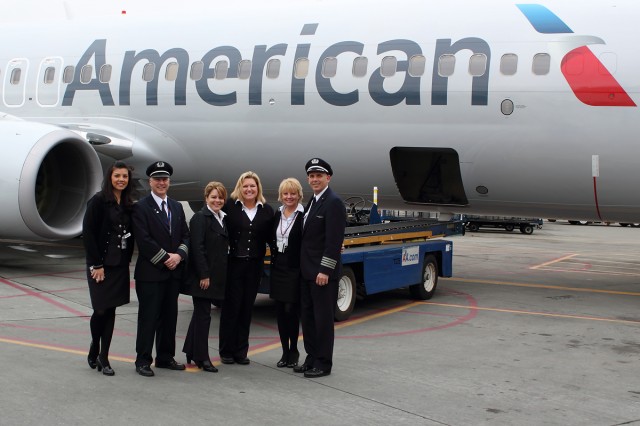
The American flight crew stopped to pose in front of the new American livery. Photo by Brandon Farris.
Everyone who was at SEA, from passengers flying through, to airport ground agents along with the TSA and FAA all seemed to make their way to the gate that it was parked at to take a sneak peak at the new scheme.
Many people working on the flight for American seemed to take a moment and bask in the new identity and even stopped for pictures. I also have to note that this was the happiest AA crew that I have ever seen and kinda wish more had their chipper personality (maybe this is truly the “new” American?).
Now with the merger coming on to the horizon, I for one, have to say that I cannot wait to see this new scheme on the A330 and think that it’ll be one of the best looking planes out there. Next thing we wanna see though is that tail on an MD-80.
If you have been able to see the new livery in person — has it changed your opinion?
MORE NEW AMERICAN LIVERY PHOTOS AT SEA:
[nggallery id=39]
 |
This story written by…Brandon Farris, Correspondent.
Brandon is an avid aviation geek based in Seattle. He got started in Photography and Reporting back in 2010. He loves to travel where ever he has to to cover the story and try to get the best darn shot possible.
@BrandonsBlog | RightStuffPhotography | Flickr |
Since the inception of the loyalty program, hotels and airlines have worked together. The relationship has always been more that the hotels just providing you points in the airline program if you stay with them. An announcement by Delta Air Lines last month has changed things considerably.

Delta Sky Priority Check In, now for SPG Platinum Elite members. Photo: Delta
Delta’s SkyMiles program has elite tiers that offer a great range of benefits to their frequent fliers including complimentary upgrades, priority boarding, check in along with much more. Starwood’s SPG Preferred Guest (SPG) program has its own elite tiers that offer bonuses like free upgrades, late check-out or complimentary Wi-Fi. The hotel & airline programs have always been similar that they reward their frequent fliers/guests with all the goodies that you want for being loyal.
As of the 1st of March, Delta & Starwood are coming together to create ’œCrossover Rewards’.
Crossover Rewards allows the Delta & Starwood top tier elite members to get similar benefits. If you are a Delta SkyMiles Platinum or Diamond Medallion member you will be able to get extra benefits at a Starwood hotel including late check-out & Free Wi-Fi access. If you are an SPG Platinum member you get benefits with Delta including a free checked bag, and also priority check in & boarding. The biggest alignment in the programs is the points earning ability.
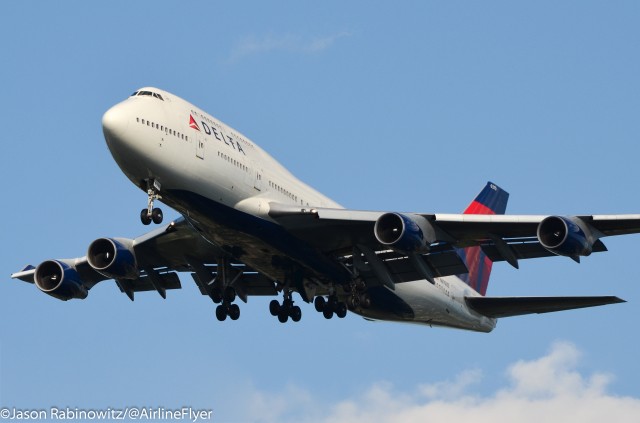
A Delta Airlines 747-400 – Photo: Jason Rabinowitz
Normally if you fly, you can only earn points with one airline or program, the same with hotels. However with Crossover Rewards you get to ’œdouble dip’. If you fly with Delta and have the SPG status you get bonus starpoints AND Delta miles. Delta fliers get the same when they stay at a Starwood property.
“Crossover Rewards is another example of Delta’s commitment to making the travel experience more beneficial and enjoyable for our customers,” said Tim Mapes, Delta’s senior vice president of marketing. “For our loyal customers, hotel accommodations are a vital component of the travel experience, which makes this new alliance with an innovative company like Starwood a strategic addition to the SkyMiles program.”
But then the relationship goes one step further. During enhancements announced by Delta to BusinessElite services on the prime transcontinental market, there was a separate little announcement that seemed to be hidden in the clutter. As of June 1st Delta will be upgrading its Business Elite bedding product to be based on the Westin Heavenly Bed.
What is the Heavenly Bed? In 1999 Westin (part of the Starwood Hotel Group) launched the Heavenly Bed range and then a year later became the first hotel company ever to sell that signature line.
“Delta is committed to providing our customers with the best possible sleep experience in the skies and we’re excited to partner with another leader in the travel category, Westin Hotels and Resorts, who shares this goal,” said Joanne Smith, Delta’s senior vice president of in-flight service. ’œThe new Westin Heavenly In-Flight bedding product is just one of the new amenities Delta is introducing to ensure customers achieve a restful, rejuvenating in-flight experience.”

A Westin Heavenly Bed at the Element Times Square West – Photo: Mal Muir | AirlineReporter.com
The new Heavenly Bed products will be launched on all BusinessElite international flights, along with the usual long haul transcontinental routes (JFK-LAX, SFO & SEA) & Atlanta to Honolulu. The new inflight product includes a Westin Heavenly Sleeping Pillow & Comforter with ’œextra luxurious loft’ and for flights over 12 hours (those ultra-long haul international flights) will get an extra lumbar pillow as well.
These two announcements bring together a new relationship that could be an industry lead in this area. Is this a sign of the future? Are we going to see other hotel chains partner up? Maybe American & Marriott or perhaps Motel 6 & Spirit.
 |
This story written by…Malcolm Muir, Lead Correspondent.
Mal is an Australian Avgeek now living and working in Seattle. With a passion for aircraft photography, traveling and the fun that combining the two can bring. Insights into the aviation world with a bit of a perspective thanks to working in the travel industry.
@BigMalX | BigMal’s World | Photos |
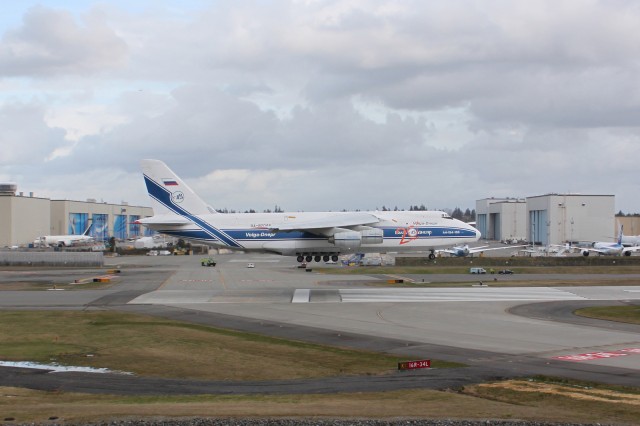
AN-124 landing at Paine Field last Saturday.
Check that off my bucket-list: sitting in the command seat of an Antonov AN-124.
This aircraft is big. The AN-124 is the world’s second largest aircraft, behind its larger cousin, the Antonov AN-225 and it is comparable in size and payload to the Boeing 747-8F and the Lockheed C-5 Galaxy.
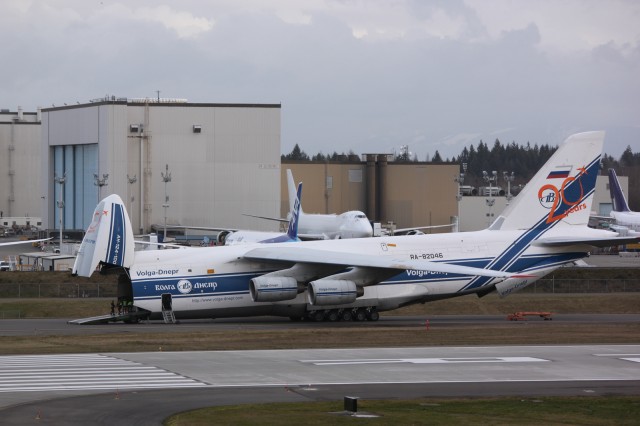
The AN-124 is kneeling with the nose up, ready to unload its cargo.
Getting solid numbers on how many have been built and are currently flying is not easy. From what I can find, it appears anywhere from 40 to 60 AN-124s have been built, with over 25 still in service today.
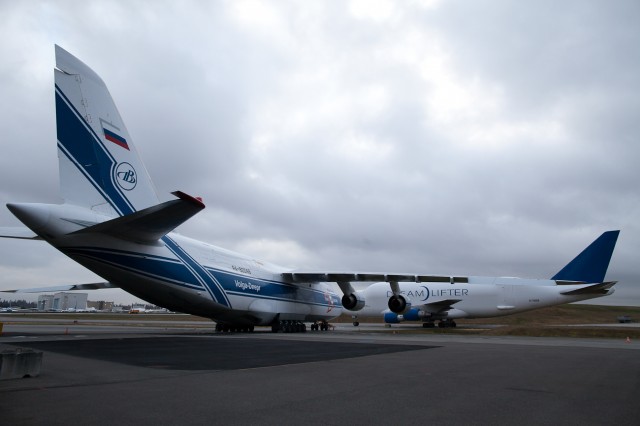
The AN-124 next to a Boeing Dreamlifter, which were both next to the Future of Flight.
The AN-124 was initially designed in the 1970’s to provide heavy transport for the Soviet military. The first airframe was started in 1979 and the first flight took place in December 1982.
BONUS: Interactive cargo loader for the AN-124
Antonov ceased building the AN-124 after the fall of the Soviet Union, but due to demand, the AN-124 was put back into production and is still currently being built and mostly sold to private airlines who fly cargo around the world.
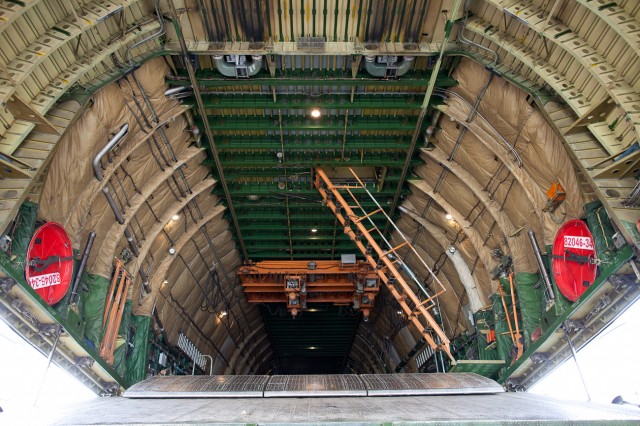
The cargo deck has its own crane system to easily load and unload cargo.
This past Saturday an AN-124 was spotted heading to Paine Field in Everett, WA. A group of AvGeeks rallied and headed to watch her land from the Strato Deck on the Future of Flight. I have seen the AN-124 a few times passing in person, but never in action — she is an impressive beast.
|
Antonov AN-124 |
Boeing 747-8F |
C-5 Galaxy |
Antonov AN-225 |
| Payload |
330,000lbs |
295,800lbs |
270,000lbs |
418,834lbs |
| Length |
226ft 3in |
250ft 2in |
247ft 1in |
275ft 7in |
| Wingspan |
240ft 5in |
224ft 7in |
222ft 9in |
290ft 0in |
| Height |
68ft 2in |
63ft 6in |
65ft 1in |
59ft 5in |
| Max Take Off Weight |
893,000lbs |
987,000lbs |
840,000lbs |
1,410,958lbs |
The aircraft that stayed a few days, RA-82046, was delivered to Volga Dnepr Airlines in 1993 and obviously still flies for them today.
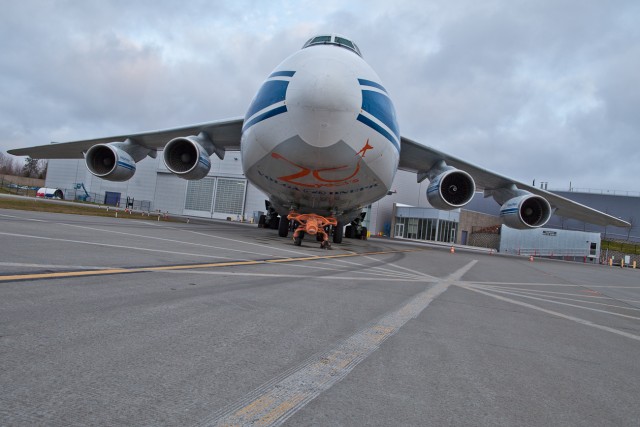
The AN-124 is not a small aircraft.
After landing at Paine Field, the AN-124 parked on the taxi way, blocking it. There was a Southwest Airlines Boeing 737 that was looking to take off and they had to taxi down the runway and turn around to make it. It was a nice comparison of size.
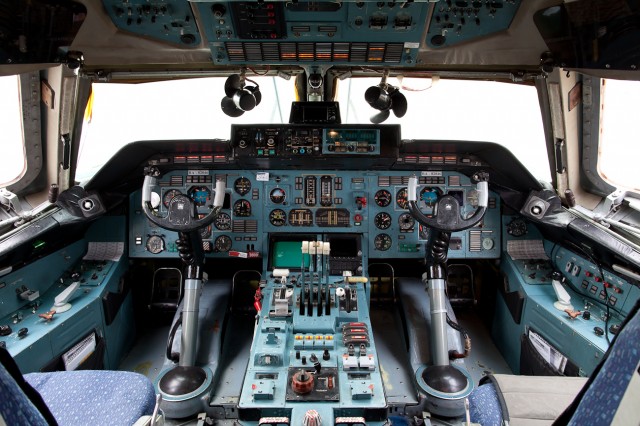
The controls of the AN-124. RA-82046
One thing I did not realize on the AN-124 is that the body can move down (much like a bus will kneel) to make the loading and unloading of cargo easier. Once the large nose lifted up, the plane lowered and two Boeing 747-8 fuselage panels were removed.
The aircraft also has an internal crane where a flat bed can pull right up to the aircraft and cargo can easily be loaded and unloaded.
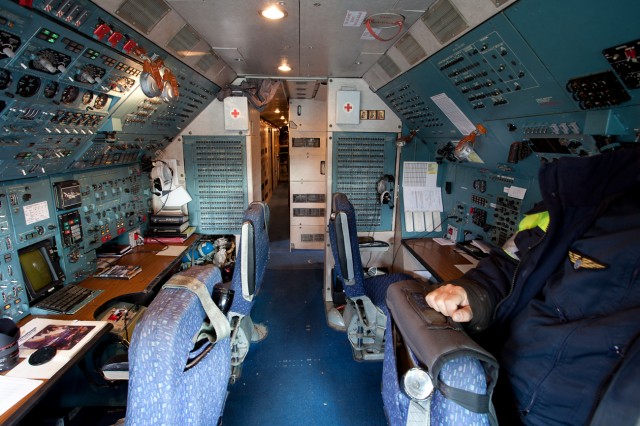
The AN-124 flight deck holds six people. It is huge.
I was lucky enough to get access to the inside of the aircraft and what a trip — it was almost like traveling through time. The flight deck was huge, seating six people: two pilots, two navigators and two engineers. I am quite certain it was larger than my first apartment in college.
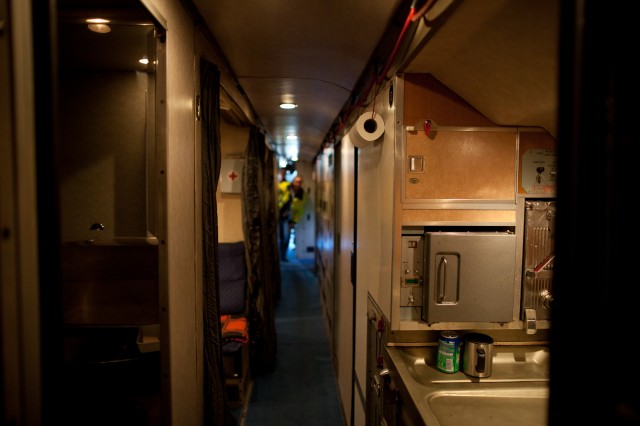
The forward part of the upper crew rest area behind the flight deck.
Behind the flight deck is a crew rest area with a lavatory, small kitchen and two seating areas that can convert into beds. There is a second upper deck behind the wings (we were not able to view) that is designed to hold up to 80 passengers or additional cargo.
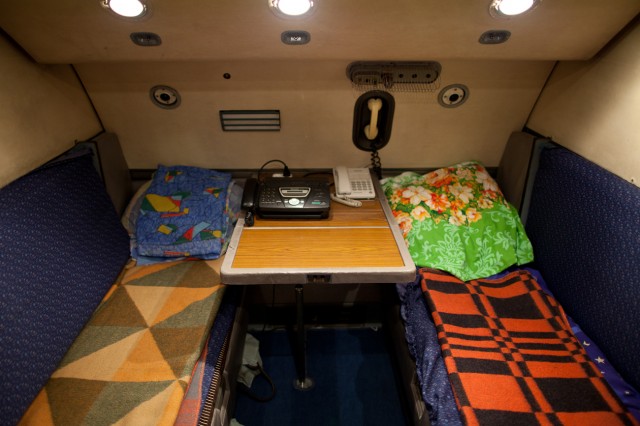
One of the crew rest nooks with fax machine.
Walking around in the AN-124 felt more like being in a submarine than it did an aircraft. Things seemed to be laid out in a utilitarian way, not necessarily for looks or atmosphere. But really… what would you expect from the aircraft? It was designed for military operations.
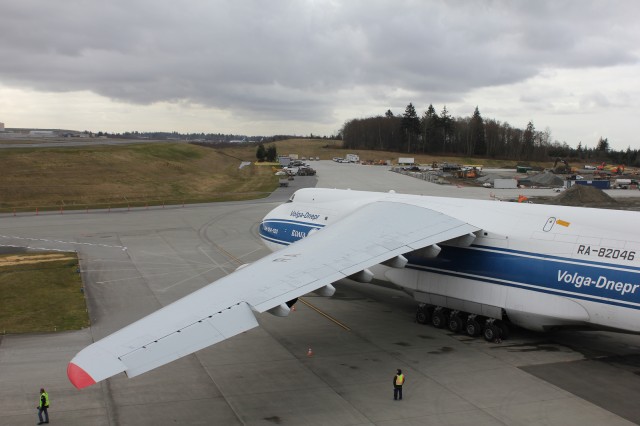
The AN-124 as seen from the Strato Deck on the Future of Flight — the Dreamlifter was moved at this point.
The AN-124 is quite versatile in what it can haul. According to Antonov’s website, the plane been used to deliver,” a 90 ton hydraulic turbines, the Liebherr large dimension mobile crane, the USA Euclid mine truck, the fuselage of the Tu-204 passenger aircraft, a 109 ton locomotive, General Electric GE90 aircraft engines, various combat vehicles, Lynx anti-submarine helicopters, a spaceship in its container and other unique cargoes.”
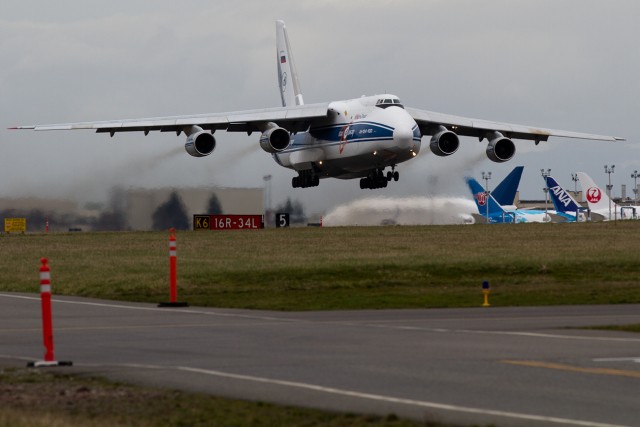
Anotonov AN-124 taking off from Paine Field on Tuesday heading to California.
Antonov continues to provide additional packages to improve the payload, range, technology and all around cost effectiveness of the AN-124. It is likely we will be seeing these beautiful flying machines well into the future.
I will also be sharing a video of the AN-124 shortly, so stay tuned. Aircraft data from Wikipedia.org
GALLERY OF ADDITIONAL ANTONOV AN-124 PHOTOS
[nggallery id=38]
Want more photos? Of course you do, here are 21 additional AN-124 photos on Flickr. And a HUGE thanks to Christine with the Future of Flight and the others who helped to make this possible!
 |
This story written by…David Parker Brown, Editor & Founder. David started AirlineReporter.com in the summer of 2008, but has had a passion for aviation since he was a kid. Born and raised in the Seattle area (where he is currently based) has surely had an influence and he couldn’t imagine living anywhere else in the world.
@AirlineReporter | Flickr | YouTube |

























